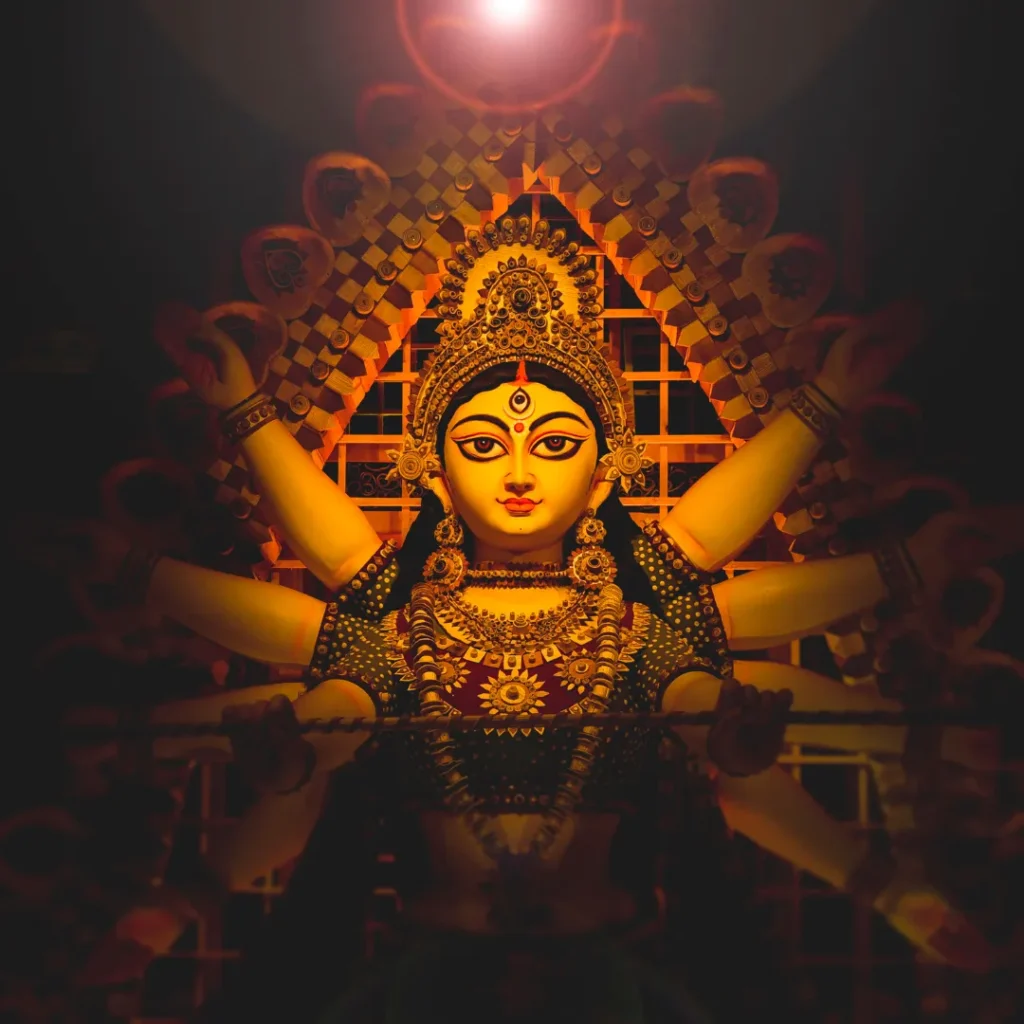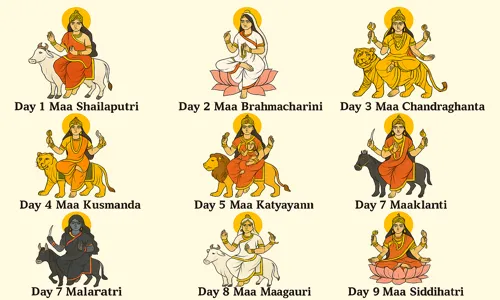

Maa Brahmacharini – Navratri 2nd Day Goddess
Maa Brahmacharini, the second form of Goddess Durga, is worshipped on the 2nd day of Navratri. She represents penance, devotion, and simplicity. Known as Brahmacharini Mata, she signifies the power of meditation and dedication. Devotees believe that worshipping her blesses them with spiritual growth, peace, and liberation.

Goddess Brahmacharini Navratri Pujan 2025
During Navratri 2025, the 2nd day of Navratri is dedicated to Maa Brahmacharini. On this day, devotees observe fasting and offer flowers, sugar, and sandalwood to the goddess. She is often depicted holding a rosary in one hand and a kamandalu (water pot) in the other, signifying her austere lifestyle. The puja involves chanting the Maa Brahmacharini mantra, lighting incense sticks, and performing aarti with devotion.
Origin of Goddess Brahmacharini
The name Brahmacharini is derived from the words “Brahma,” meaning supreme knowledge, and “Charini,” meaning one who practices or follows. According to Hindu mythology, she is the unmarried form of Goddess Parvati, who undertook severe penance to attain Lord Shiva as her husband. This form highlights the power of penance and sacrifice.
Maa Brahmacharini Devi Life Story
माता ब्रह्मचारिणी का जन्म हिमालय राज के घर हुआ था। इनका स्वरूप अत्यंत तेजस्वी और सरल है। पिछले जन्म में इन्होंने भगवान शिव को पति रूप में प्राप्त करने के लिए कठोर तपस्या की थी। वर्षों तक कठिन ब्रह्मचर्य व्रत और उपवास करके इन्होंने घोर तप किया, जिसके कारण इनका नाम “ब्रह्मचारिणी” पड़ा। माता के एक हाथ में जप की माला और दूसरे हाथ में कमंडलु सुशोभित है। उनकी साधना और तपस्या से प्रसन्न होकर भगवान शिव ने इन्हें अपनी अर्धांगिनी के रूप में स्वीकार किया।

Goddess Brahmacharini During Navratri
Though Maa Brahmacharini is worshipped on the 2nd day of Navratri, her energy is revered throughout the nine days. Along with her, devotees also worship other forms like Maa Shailputri, Maa Chandraghanta, Maa Kushmanda, Katyayani Mata, and Skandamata on their respective days. Each form has unique significance. For example, Navratri 4th day is for Maa Kushmanda, day 5 Navratri goddess is Skandamata, and day 6 Navratri goddess is Maa Katyayani. This shows the connection between all forms of Durga.
Which Color Is the Most Auspicious for Navratri 2nd Day?
For the second day of Navratri, known as Dwitiya, the auspicious color is Red. This vibrant color represents the passion, energy, and dedication embodied by Maa Brahmacharini, who is worshipped on this day.
Maa Brahmacharini Mantra
Chanting the Maa Brahmacharini mantra is believed to bring peace, strength, and spiritual knowledge. The most popular mantra is:
“Om Devi Brahmacharinyai Namah”
|| ॐ ऐं ह्रीं क्लीं ब्रह्मचारिण्यै नमः ||
Maa Brahmacharini Aarti/ मां ब्रह्मचारिणी जी की आरती
जय ब्रह्मचारिणी माता, जय जय अम्बे माता।
सच्चिदानंद स्वरूपिणी, वरदा भवानी माता॥
एक हाथ में माला, दूजे में कमंडलु धारी।
शिवप्रिय तुम्ही हो माता, तपस्या की अधिकारी॥
ध्यान लगाकर तुमको, हर दुःख मिट जाता।
सुख-समृद्धि मिलती माता, जीवन सफल हो जाता॥
जय ब्रह्मचारिणी माता, जय जय अम्बे माता।
सच्चिदानंद स्वरूपिणी, वरदा भवानी माता॥
9 Days of Navratri Devi Names and Colours
Celebrate the power of the divine this Navratri! The sacred Hindu festival, dedicated to Goddess Durga and her nine forms, is a nine-day journey of devotion. Each day has a specific Goddess, color, and story, and wearing the corresponding color is believed to attract blessings. Starting September 22, 2025, join the festivities known as Dasara Navaratri and mark the victory of good over evil. Explore the complete guide to the 9 days of navratri devi names, including colors, rituals, and aarti for 2025.
FAQs : Maa Brahmacharini
Who is Maa Brahmacharini?
Maa Brahmacharini is the second form of Navdurga, symbolizing penance and devotion.
When is Maa Brahmacharini worshipped?
She is worshipped on the second day of Navratri during the nine-day festival.
What are the benefits of worshipping Brahmacharini Mata?
She blesses devotees with spiritual growth, self-control, and peace of mind.
Which other goddesses are worshipped during Navratri?
Devotees worship Maa Shailputri, Maa Chandraghanta, Maa Kushmanda, Skandamata, and Maa Katyayani, among others.